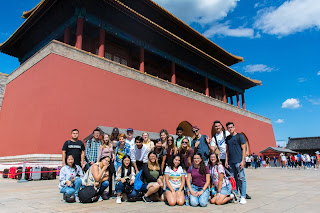中秋快乐!
Happy
Mid-Autumn Festival Everyone!
Today
was the Mid-Autumn Festival (中秋节).
It is also called the Mooncake Festival/Celebration. Today, you are supposed to eat all the mooncakes you want. Mooncakes (月饼)
are small pastries with a rich, thick filling such as red bean or egg yolk inside. They are more commonly eaten in the south of China in places such as Guangdong, Guangxi, Hong Kong, and Macau. The Mid-Autumn Festival is a harvest
festival celebrated on the 15th day
of the 8th month
of the lunar calendar. It was a celebration of the end of the autumn harvest. The festival celebrates three fundamental concepts: 1. gathering: Chinese people return home and spend time with family and friends. The full moon is said to represent family reunion
and that is why the Mid-Autumn Festival is so important. 2. Thanksgiving: give thanks for the harvest. 3. Praying: asking for conceptual or material satisfaction such as babies, a spouse, beauty, longevity, etc.
I
also was able to attend a concert tonight with some friends. We saw 梁祝小提琴协奏曲 which
translates to Butterfly Lovers’ Violin Concerto. This is my Chinese friend’s favorite musical piece. I have
to agree,
it was quite great. We were fortunate enough to have one of the composers Hu Zhanhao (何占豪) conducting.
Before the concert began, he talked about what it was like composing musical during the Cultural Revolution. His story reminded me of a Chinese film called Youth
(芳华). The
film is about an arts troupe during the Cultural Revolution and I imagined Hu Laoshi to
be composing music for an arts troupe. Whether he did or not, I don’t know. I didn’t understand much of what he was saying. The story of Butterfly Lover’s Violin Concerto is similar
to that
of Romeo and Juliet. Basically, the story is about a young woman (Zhu) who, disguised as a boy, meets a boy (Liang) on her way to school. This takes place in traditional China when women were not
allowed to go to school. Zhu and Liang make a vow of fraternity. During the three years of school, they become really
close.
Zhu tells the Liang to go to her home and court her sister. Zhu is actually
inviting him
to marry her since she doesn’t have a sister. However, Zhu finds out that her father is planning on marrying her to a rich man. Her and her father fight. Then Liang comes back, falls ill, and dies. Zhu commits suicide to be with Liang and not marry the other
man. The concert ends with the two being transformed into butterflies, never to be separated again.
It’s rather dramatic and the music portrays that rather nicely. The soloists were very
good as well. At the end, they – along with the composer – were presented with flowers which they in turn gave to members of the orchestra. My friend said that Chinese people are too humble and don’t like to accept gifts, so
they try to give them away. I thought this was very interesting.
Hope
everyone has a good Mid-Autumn Festival and if you find a mooncake eat it.
再见!
Until
next week!
马乐






















